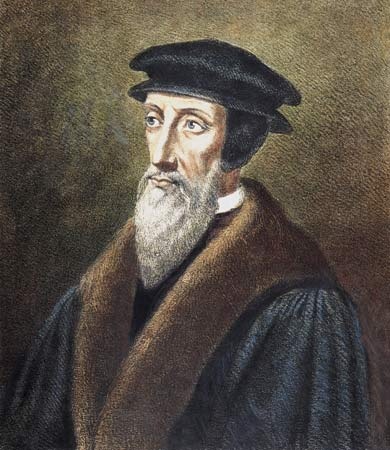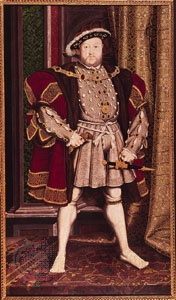Reformation
Christianity
 the religious revolution that took place in the Western church in the 16th century; its greatest leaders undoubtedly were Martin Luther (Luther, Martin) and John Calvin (Calvin, John). Having far-reaching political, economic, and social effects, the Reformation became the basis for the founding of Protestantism (Protestant Heritage), one of the three major branches of Christianity.
the religious revolution that took place in the Western church in the 16th century; its greatest leaders undoubtedly were Martin Luther (Luther, Martin) and John Calvin (Calvin, John). Having far-reaching political, economic, and social effects, the Reformation became the basis for the founding of Protestantism (Protestant Heritage), one of the three major branches of Christianity.The world of the late medieval Roman Catholic church from which the 16th-century Reformers emerged was a complex one. Over the centuries the church, particularly in the office of the papacy, had become deeply involved in the political life of western Europe. The resulting intrigues and political manipulations, combined with the church's increasing power and wealth, contributed to the bankrupting of the church as a spiritual force. Abuses such as the sale of indulgences (indulgence) (or spiritual privileges) by the clergy and other charges of corruption undermined the church's spiritual authority. These instances must be seen as exceptions, however, no matter how much they were played up by polemicists. For most people, the church continued to offer spiritual comfort. There is some evidence of anticlericalism, but the church at large enjoyed loyalty as it had before. One development is clear: the political authorities increasingly sought to curtail the public role of the church and thereby triggered tension.
The Reformation of the 16th century was not unprecedented. Reformers within the medieval church such as St. Francis of Assisi (Francis of Assisi, Saint), Valdes (founder of the Waldensians (Waldenses)), Jan Hus (Hus, Jan), and John Wycliffe (Wycliffe, John) addressed aspects in the life of the church in the centuries before 1517. In the 16th century Erasmus of Rotterdam (Erasmus, Desiderius), a great Humanist scholar, was the chief proponent of liberal Catholic reform that attacked popular superstitions in the church and urged the imitation of Christ as the supreme moral teacher. These figures reveal an ongoing concern for renewal within the church in the years before Luther (Luther, Martin) is said to have posted his Ninety-five Theses on the door of the Castle Church, Wittenberg, Germany, on October 31, 1517, the eve of All Saints' Day—the traditional date for the beginning of the Reformation. (See Researcher's Note.)
Martin Luther claimed that what distinguished him from previous reformers was that while they attacked corruption in the life of the church, he went to the theological root of the problem—the perversion of the church's doctrine of redemption (salvation) and grace. Luther, a pastor and professor at the University of Wittenberg, deplored the entanglement of God's free gift of grace in a complex system of indulgences (indulgence) and good works. In his Ninety-five Theses, he attacked the indulgence system, insisting that the pope had no authority over purgatory and that the doctrine of the merits of the saints had no foundation in the gospel. Here lay the key to Luther's concerns for the ethical and theological reform of the church: scripture alone is authoritative (sola sciptura) and justification is by faith (sola fide), not by works. While he did not intend to break with the Catholic church, a confrontation with the papacy was not long in coming. In 1521 Luther was excommunicated; what began as an internal reform movement had become a fracture in western Christendom.
The Reformation movement within Germany diversified almost immediately, and other reform impulses arose independently of Luther. Huldrych Zwingli (Zwingli, Huldrych) built a Christian theocracy in Zürich in which church and state joined for the service of God. Zwingli agreed with Luther in the centrality of the doctrine of justification by faith, but he espoused a different understanding of the Holy Communion (Eucharist). Luther had rejected the Catholic church's doctrine of transubstantiation, according to which the bread and wine in Holy Communion became the actual body and blood of Christ. According to Luther's notion, the body of Christ was physically present in the elements because Christ is present everywhere, while Zwingli claimed that entailed a spiritual presence of Christ and a declaration of faith by the recipients.
Another group of reformers, often though not altogether correctly referred to as “radical reformers,” insisted that Baptism be performed not on infants but on adults who had professed their faith in Jesus. Called Anabaptists (Anabaptist), they remained a marginal phenomenon in the 16th century but survived—despite fierce persecution—as Mennonites (Mennonite) and Hutterites (Hutterite) into the 21st century. Opponents of the ancient Trinitarian dogma made their appearance as well. Known as Socinians (Socinian), after the name of their founder, they established flourishing congregations, especially in Poland.
 Another important form of Protestantism (as those protesting against their suppressions were designated by the Diet of Speyer in 1529) is Calvinism, named for John Calvin (Calvin, John), a French lawyer who fled France after his conversion to the Protestant cause. In Basel, Switzerland, Calvin brought out the first edition of his Institutes of the Christian Religion in 1536, the first systematic, theological treatise of the new reform movement. Calvin agreed with Luther's teaching on justification by faith. However, he found a more positive place for law within the Christian community than did Luther. In Geneva, Calvin was able to experiment with his ideal of a disciplined community of the elect. Calvin also stressed the doctrine of predestination and interpreted Holy Communion as a spiritual partaking of the body and blood of Christ. Calvin's tradition merged eventually with Zwingli's into the Reformed tradition, which was given theological expression by the (second) Helvetic Confession of 1561.
Another important form of Protestantism (as those protesting against their suppressions were designated by the Diet of Speyer in 1529) is Calvinism, named for John Calvin (Calvin, John), a French lawyer who fled France after his conversion to the Protestant cause. In Basel, Switzerland, Calvin brought out the first edition of his Institutes of the Christian Religion in 1536, the first systematic, theological treatise of the new reform movement. Calvin agreed with Luther's teaching on justification by faith. However, he found a more positive place for law within the Christian community than did Luther. In Geneva, Calvin was able to experiment with his ideal of a disciplined community of the elect. Calvin also stressed the doctrine of predestination and interpreted Holy Communion as a spiritual partaking of the body and blood of Christ. Calvin's tradition merged eventually with Zwingli's into the Reformed tradition, which was given theological expression by the (second) Helvetic Confession of 1561.The Reformation spread to other European countries over the course of the 16th century. By mid century, Lutheranism dominated northern Europe. Eastern Europe offered a seedbed for even more radical varieties of Protestantism, because kings were weak, nobles strong, and cities few, and because religious pluralism had long existed. Spain and Italy were to be the great centres of the Counter-Reformation, and Protestantism never gained a strong foothold there.
 In England the Reformation's roots were both political and religious. Henry VIII, incensed by Pope Clement VII (Clement VII)'s refusal to grant him an annulment of his marriage, repudiated papal authority and in 1534 established the Anglican Church (Anglicanism) with the king as the supreme head. In spite of its political implications, the reorganization of the church permitted the beginning of religious change in England, which included the preparation of a liturgy in English, the Book of Common Prayer. In Scotland, John Knox (Knox, John), who spent time in Geneva and was greatly influenced by John Calvin, led the establishment of Presbyterianism (Reformed and Presbyterian churches), which made possible the eventual union of Scotland with England. For further treatment of the Reformation, see Protestantism, history of (Protestantism). For a discussion of the religious doctrine, see Protestantism (Protestant Heritage).
In England the Reformation's roots were both political and religious. Henry VIII, incensed by Pope Clement VII (Clement VII)'s refusal to grant him an annulment of his marriage, repudiated papal authority and in 1534 established the Anglican Church (Anglicanism) with the king as the supreme head. In spite of its political implications, the reorganization of the church permitted the beginning of religious change in England, which included the preparation of a liturgy in English, the Book of Common Prayer. In Scotland, John Knox (Knox, John), who spent time in Geneva and was greatly influenced by John Calvin, led the establishment of Presbyterianism (Reformed and Presbyterian churches), which made possible the eventual union of Scotland with England. For further treatment of the Reformation, see Protestantism, history of (Protestantism). For a discussion of the religious doctrine, see Protestantism (Protestant Heritage).- polystyrene
- polysulfide
- polysulfone
- Polytechnical Museum
- polytetrafluoroethylene
- polytheism
- polytonality
- polyurethane
- polyvinyl acetate
- polyvinyl alcohol
- polyvinyl chloride
- polyvinyl fluoride
- Polyxena
- pomander
- Pomare, Sir Maui
- Pomatorhinidae
- Pombal, Sebastião de Carvalho, marquês de
- pomegranate
- Pomerania
- Pomeranian
- Pomeranian Lakeland
- pomerium
- pomfret
- Pomigliano d'Arco
- pommel horse